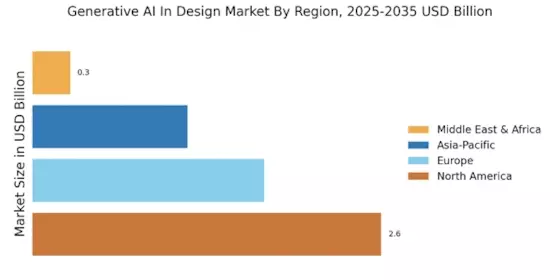The Generative AI In Design Market is currently characterized by a dynamic competitive landscape, driven by rapid technological advancements and increasing demand for innovative design solutions. Key players such as Adobe (US), Autodesk (US), and NVIDIA (US) are at the forefront, leveraging their extensive resources to enhance their product offerings. Adobe (US) has positioned itself as a leader in creative software, focusing on integrating AI capabilities into its suite of tools to streamline design processes. Autodesk (US), known for its design software, emphasizes collaboration and cloud-based solutions, which are increasingly vital in a globalized market. Meanwhile, NVIDIA (US) continues to innovate in AI hardware and software, providing the computational power necessary for generative design applications. Collectively, these strategies foster a competitive environment that prioritizes innovation and user-centric solutions.
In terms of business tactics, companies are increasingly localizing their operations and optimizing supply chains to enhance efficiency and responsiveness to market demands. The competitive structure of the Generative AI In Design Market appears moderately fragmented, with numerous players vying for market share. However, the influence of major companies is substantial, as they set industry standards and drive technological advancements that smaller firms often follow.
In September 2025, Adobe (US) announced the launch of its new AI-driven design tool, which utilizes machine learning algorithms to assist designers in creating personalized content more efficiently. This strategic move not only reinforces Adobe's commitment to innovation but also positions it to capture a larger share of the market by appealing to a broader range of creative professionals. The introduction of such tools is likely to enhance user engagement and retention, thereby solidifying Adobe's market leadership.
In August 2025, Autodesk (US) expanded its partnership with various educational institutions to integrate generative design principles into their curricula. This initiative aims to cultivate a new generation of designers proficient in AI technologies, ensuring a steady pipeline of talent for the industry. By investing in education, Autodesk (US) not only strengthens its brand presence but also fosters a community that is aligned with its technological vision, potentially leading to increased adoption of its software solutions.
In July 2025, NVIDIA (US) unveiled a new suite of AI tools designed specifically for the architecture and engineering sectors. This strategic development highlights NVIDIA's focus on niche markets within the broader design landscape, allowing it to cater to specialized needs while enhancing its overall product portfolio. The introduction of these tools is expected to drive significant interest from professionals seeking cutting-edge solutions, thereby reinforcing NVIDIA's competitive edge.
As of October 2025, the competitive trends in the Generative AI In Design Market are increasingly defined by digitalization, sustainability, and the integration of AI technologies. Strategic alliances among key players are shaping the landscape, fostering innovation and collaboration. Looking ahead, it is anticipated that competitive differentiation will evolve, shifting from traditional price-based competition to a focus on innovation, technological advancements, and supply chain reliability. This transition underscores the importance of adaptability and forward-thinking strategies in maintaining a competitive advantage.


















Leave a Comment